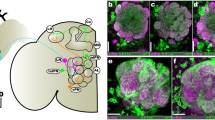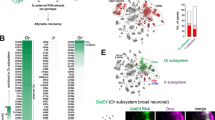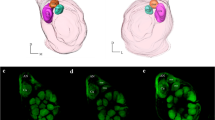Abstract.
Single-cell electrophysiological recordings were obtained from olfactory receptor neurons housed in sensilla trichodea along the adult antennae arising from transplantation of the antennal imaginal discs between larval male Helicoverpa zea and Heliothis virescens. The olfactory receptor neurons from the majority of type C sensilla sampled on transplanted antennae displayed response characteristics consistent with those of the species that donated the antennae. However, some of the sensilla type C sampled in either transplant type contained olfactory receptor neurons that responded in a manner typical of the recipient species or other neurons that have not previously been found in the type C sensilla of either species. The single-cell data help to explain behavioral results showing that some transplant males do fly upwind to both species' pheromone blends, an outcome not expected based on known antennal sensory phenotypes. Our results suggest that host tissue can influence antennal olfactory receptor neuron development, and further that because of a common phylogenetic ancestry the donor tissue has the genetic capability to produce a variety of sensillar and receptor types.
Similar content being viewed by others
Author information
Authors and Affiliations
Additional information
Electronic Publication
Rights and permissions
About this article
Cite this article
Ochieng, .S., Poole, .K., Linn, .C. et al. Unusual pheromone receptor neuron responses in heliothine moth antennae derived from inter-species imaginal disc transplantation. J Comp Physiol A 189, 19–28 (2003). https://doi.org/10.1007/s00359-002-0371-1
Received:
Revised:
Accepted:
Issue Date:
DOI: https://doi.org/10.1007/s00359-002-0371-1




